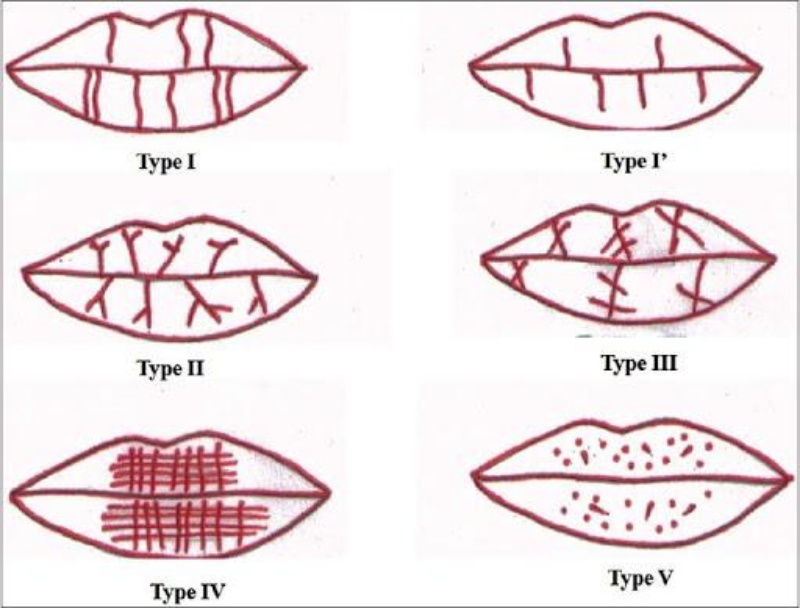
DIFFERENT METHODS OF CHEILOSCOPY EXAMINATION
- By Mr. Kundal Andrew Ruguebe
ABSTRACT
Identity perfoms totally critical function in any crime research. Cheiloscopy helps in identifying the human beings primarily based on the lips traces. The pattern of wrinkles on the lips has person characteristics like fingerprints. A overview of the literature well known shows little or no studies accomplished on lip prints so far. The prevailing article critiques in element the history, scope of cheiloscopy and the usage of lip prints in crime detection. It also highlights the current research carried out inside the subject of cheiloscopy. An effort has been made to assist the researchers via reviewing in element the various methods of classifying and studying the lip prints.
INTRODUCTION
One of the greatest challenges facing humans is human identification. Identification is a fundamental process in civil and criminal forensics and it is used for personal, social and legal reasons only. It is also a prerequisite for death diagnos where fingerprint analysis, dental pads, and deoxyribonucleic acid (DNA) are the most commonly used techniques that enable a rapid and safe identification process. However, in certain situations related to crime scenes or lack of experienced personnel, these techniques may not be available. Therefore, as in the case of soft tissue identification, there is a growing need for alternative methods of identification, an example of which is cheiloscopy. Cheiloscopy is the area of forensics concerned with the examination, registration, and classification of labial casts (Sharma, et al., 2009).
As mentioned earlier identity plays a completely essential role in any crime research. The advent of fingerprints within the starting of the past century because the handiest reliable approach of human identity changed into due to the tremendous works of three outstanding persons thus Sir William Herschel, Sir Francis Galton, and Sir Edward Henry. Fingerprint device turned into first utilized in India in 1858 via Sir William Herschel. In individuals, the fingerprint patterns are specific and permanent, and hence considered as the manual to identification. Many a time, the substances with which a crook may additionally are available in contact are unlikely to receive fingerprints of sufficient clarity to be useful as evidence. Attention of the modern-day strategies of crime detection has alerted the criminals for taking enough precautions just like the use of gloves, so in such occasions, the identity of criminals the usage of correct methods like fingerprint evaluation fails to set up a advantageous identification. The investigators can depend on cheiloscopy as supportive evidence in specific investigations. Cheiloscopy, deals with the identification of humans based on lip traces, it is also based on the fact that the pattern of lines on the red part of human lips are unique for each human being. It plays a major role as a stomatological means of identification in addition to bite marks, tooth morphology, restorations and palatal rugae patterns. Research indicates the existence of heredity in the lip prints (Prabhu, et al., 2012).
Lip prints are unique and do not change during the entire life of a person1. It has been verified that lip prints recover after undergoing alterations like trauma, inflammation and diseases like Herpes etc. The disposition and form of furrows does not vary with environmental factors. The lip prints of parents and children and those of siblings have shown some similarities. It has also been suggested that variation in pattern among males and females could help in personal identification and sex determination (Reddy, 2011).
DISCUSSION
Lip prints were first recommended as a tool for identification as early as 1932 by Edmond Locard, one of France’s greatest criminologists. The biological phenomenon of systems of furrows on the red part of human lips was first described by Anthropologists R. Fischer in 19023. In 1961, the first research in Europe was carried out on the subject of lip prints in Hungary. The examination started when lip traces were found on a glass door at the scene of murder. In Poland, the interest in lip prints started in 1966, when accidentally a lip print was revealed on the window glass at the scene of burglary. Research was carried out later and its results were comparable to those achieved in Japan and Hungary (Suzuki & Tsuchihashi, 1970).
In 1971, Kazuo Suzuki and Yasuo Tsuchihashi conducted further research on identical twins. They divided the lip into four quadrants and developed their own classification of six different types of grooves. They suggested that no two lip prints show the same pattern and that lip prints of single-ovum twins are very similar, and that those features could be inherited from either parent. This was further confirmed by Tsuchihashi in his longitudinal study involving 1364 individual and family groups. These results strengthened the theory of lip print inheritance. He found that lip prints did not change over time. In his study, he observed that no two identical twins had exactly the same lip print pattern. He also found that after inflicting trauma to the lip, it resumed its grooved pattern after it healed. Therefore it turned out that the placement of the lines on lips is personal and unique to each person (Suzuki & Tsuchihashi, 1970).
Cheiloscopy has been used a lot in the past years and proved to be successful for instance, in 1966 in Poland cheiloscopy proved to be helpful in solving the case of burglary. The analysis by expert was done and it was found that the lip impression found on crime scene did not match with suspect and thus helped in proceeding further in investigation. Also in 1988, a burglary case in grocery store was solved due to the lip prints found. Lip prints were found along with the tooth marks on a piece of cake. The analysis revealed that the person who had left the trace was one of the burglars. The results of both tooth mark and lip prints supported the idea of involvement of that burglar (Kasprzak, 1990).
Lip prints are also developed differently using different substances depending on where they are. They are mainly three types namely powder method, chemical method and x-ray method. Powder method is usually used to identify latent prints on nonporous surfaces such as glass, marble, metal and finished wood. When the powder is distributed on the surface, it adheres to the residue deposited from the fingers touch allowing investigators to find the print. Aluminum powder method and magnetic powder method are some of the methods used to develop lip print. Chemical method, this is when crime scene investigators uses chemicals to locate lip prints. Such chemicals are small particle reagent(SPR), lysochrome dyes, silver nitrate and iodine fuming. When one of these chemicals comes into contact 0with the chemicals present in the lip prints thus fats and natural oils the print becomes visible. Lastly the x-ray method, this is when lead powder is distributed on suspected area with the help of a brush. The dusted area is then x-rayed and then photographic film of x-ray should be treated with required chemicals. However sometimes the lip prints might be on multicolored surfaces they are methods used to develop lip prints on such surfaces. These methods are Sudan black reagent which can be applied directly to the print, Nile red reagent and yellow fluorescent powder. After one of these methods is used lip prints need to be lifted and they are only two ways that can be done namely photographic method and transparent tape method. Photographic method thus when the developed prints should always be photographed using a fixed camera or variable zoom photographic camera with the help of measuring and transparent method is when powder dusted lip prints can be lifted with help of transparent tape from a liquid and hard surface (Babu, n.d.).
Lips are also classified into different categories depending on what they look like. Lip prints can be classified and further analyzed only when a clear image is obtained therefore it means lip prints should be collected and recorded carefully to prevent future problems. In 1966, Dr. Santos categorized the nature of wrinkles and grooves into simple and complex types. Simple characters are further divided into four groups thus straight lines, curved lines, diagonal lines, and sinusoidal lines. Complex types were further subdivided into bifurcated, trifurcated, and anomalous groups. Santos also classified lips as thin, medium, thick, and mixed based on their thickness. Thin lips are commonly found in Europeans and a medium lip is 8-10 mm thick and has a more rounded pink zone. This type is more common in the general population. Thick or very thick lips are very large and the strands of the lips look backwards and this is the characteristic of blacks. Mixed lip types were very common among Orientals. Santos also reported various types of commissures, such as horizontal, flat and ridged. On other hand, Suzuki and Tsuchihashi named the grooves existing on the labiorum rubrorum as “sulci labiorum rubrorum” and the lip prints consisting of these grooves as “Figura linearum labiorum rubrorum,” for example in general, “lip print,” and thus evolved a new classification of lip prints. Lip prints were classified into six types according to the shape and course of the grooves as shown on the diagrams below (Prabhu, et al., 2010).
Type I- Straight grooves that extend throughout the lip
Type I’- Straight grooves but are not present throughout the entire breadth of lip
Type II- Forked grooves
Type III- Intersecting grooves
Type IV- Reticulate grooves
Type V- Undetermined
CONCLUSION
A lip print is a fingerprint randomly left at a crime scene and used in criminal investigations to identify a criminal or a deceased person. They must be carefully checked and analysed by experts. Cheiloscopy is an emerging field of forensics today and various intensive studies and studies have been conducted on lip prints and their identification. The vast amount of research in the field of cheiloscopy and ongoing research into potential lip impressions confirms the fact that the potential for identifying individuals using the red part of the lips is greater than is commonly believed.
References
Babu, G., n.d. Lip Print. Cheiloscopy, pp. 1-19.
Kasprzak, J., 1990. Possibilities of cheiloscopy. Forensic Science International, pp. 145-151.
Prabhu, R., Dinkar, A. D., Prabhu, V. D. & Rao, P. K., 2012. Cheiloscopy: revisited. Journal of forensic dental sciences, p. 47.
Prabhu, R., Dinkar, A. & Prabhu, V., 2010. Collection of Lip prints as forensic evidence at the crime scene. An Insight. J Oral Health Res, pp. 29-35.
Reddy, L., 2011. Lip Prints: An Overvoew in Forensic Dentistry. Journal of Advanced Dental Research, pp. 17-20.
Sharma, P., Saxena, S. & Rathod, V., 2009. Comparative Reliability of Cheiloscopy and Palatoscopy in Human Identification. Indian Journal of Dental Research, pp. 453-4457.
Suzuki, K. & Tsuchihashi, Y., 1970. Personal identification by means of lip prints. J Forensic Med, p. 7.
Written By:
KUNDAI ANDREW RUGUBE [INTERN ID:AFRS_IP2304]
UNIVERSIRTY OF ZIMBABWE
BACHELOR OF SCIENCE DEGREE IN FORENSIC SCIENCE (FORENSIC BIOLOGY AND BIOCHEMISTRY)
